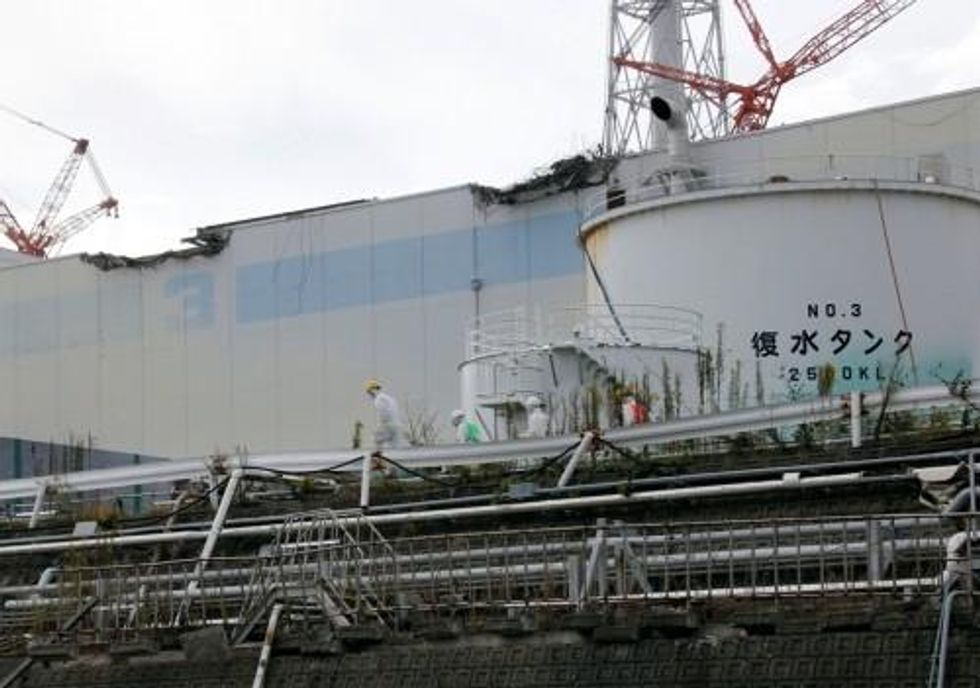

SUBSCRIBE TO OUR FREE NEWSLETTER
Daily news & progressive opinion—funded by the people, not the corporations—delivered straight to your inbox.
5
#000000
#FFFFFF
To donate by check, phone, or other method, see our More Ways to Give page.


Daily news & progressive opinion—funded by the people, not the corporations—delivered straight to your inbox.

"The leaked water is highly likely to have come from the water that was already used to cool fuel rods, and not from leaked rainwater or cooling water (on its way to the reactor)," stated a TEPCO official, according to The Asahi Shimbun.
TEPCO reportedly made the determination when samples of the leaked water were found to be hotter and more radioactive than rainwater and unused cooling water.
The new revelations follow TEPCO's announcement on Saturday that a 30 centimeter leak was found by workers viewing a video feed that showed the inside the No. 3 building. The company claimed that the water was leaking into the basement of the building but not beyond its structure.
At the time, TEPCO officials said they did not know the source of the leak. Media reports suggest that leaking cooling water is one of the more dismal potential causes.
"If the leak is from water being used to cool the reactor, it would be highly contaminated and a new headache for TEPCO and the government," reported The Asahi Shimbun on Sunday, discussing the potential cause of the leak before it was known. "A series of leaks from storage tanks of water that had been used to cool the damaged reactors and problems with groundwater entering reactor buildings and mixing with radioactive water there has hampered the plant's decommissioning process."
_____________________
Dear Common Dreams reader, The U.S. is on a fast track to authoritarianism like nothing I've ever seen. Meanwhile, corporate news outlets are utterly capitulating to Trump, twisting their coverage to avoid drawing his ire while lining up to stuff cash in his pockets. That's why I believe that Common Dreams is doing the best and most consequential reporting that we've ever done. Our small but mighty team is a progressive reporting powerhouse, covering the news every day that the corporate media never will. Our mission has always been simple: To inform. To inspire. And to ignite change for the common good. Now here's the key piece that I want all our readers to understand: None of this would be possible without your financial support. That's not just some fundraising cliche. It's the absolute and literal truth. We don't accept corporate advertising and never will. We don't have a paywall because we don't think people should be blocked from critical news based on their ability to pay. Everything we do is funded by the donations of readers like you. Will you donate now to help power the nonprofit, independent reporting of Common Dreams? Thank you for being a vital member of our community. Together, we can keep independent journalism alive when it’s needed most. - Craig Brown, Co-founder |

"The leaked water is highly likely to have come from the water that was already used to cool fuel rods, and not from leaked rainwater or cooling water (on its way to the reactor)," stated a TEPCO official, according to The Asahi Shimbun.
TEPCO reportedly made the determination when samples of the leaked water were found to be hotter and more radioactive than rainwater and unused cooling water.
The new revelations follow TEPCO's announcement on Saturday that a 30 centimeter leak was found by workers viewing a video feed that showed the inside the No. 3 building. The company claimed that the water was leaking into the basement of the building but not beyond its structure.
At the time, TEPCO officials said they did not know the source of the leak. Media reports suggest that leaking cooling water is one of the more dismal potential causes.
"If the leak is from water being used to cool the reactor, it would be highly contaminated and a new headache for TEPCO and the government," reported The Asahi Shimbun on Sunday, discussing the potential cause of the leak before it was known. "A series of leaks from storage tanks of water that had been used to cool the damaged reactors and problems with groundwater entering reactor buildings and mixing with radioactive water there has hampered the plant's decommissioning process."
_____________________

"The leaked water is highly likely to have come from the water that was already used to cool fuel rods, and not from leaked rainwater or cooling water (on its way to the reactor)," stated a TEPCO official, according to The Asahi Shimbun.
TEPCO reportedly made the determination when samples of the leaked water were found to be hotter and more radioactive than rainwater and unused cooling water.
The new revelations follow TEPCO's announcement on Saturday that a 30 centimeter leak was found by workers viewing a video feed that showed the inside the No. 3 building. The company claimed that the water was leaking into the basement of the building but not beyond its structure.
At the time, TEPCO officials said they did not know the source of the leak. Media reports suggest that leaking cooling water is one of the more dismal potential causes.
"If the leak is from water being used to cool the reactor, it would be highly contaminated and a new headache for TEPCO and the government," reported The Asahi Shimbun on Sunday, discussing the potential cause of the leak before it was known. "A series of leaks from storage tanks of water that had been used to cool the damaged reactors and problems with groundwater entering reactor buildings and mixing with radioactive water there has hampered the plant's decommissioning process."
_____________________